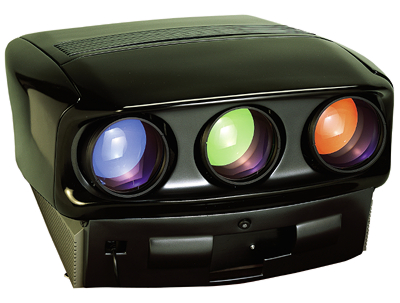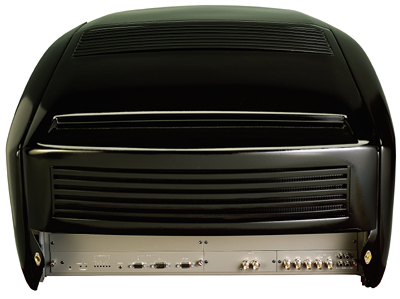Reference Imaging CinePro 9x Elite & Teranex HDX Cinema MX

Of course, if you've glanced at the specifications of the two products under evaluation here, you're likely to answer, "No, we're in Fantasyland." And if you're referring to the price, you're probably right. Only a small fraction of you will be able to consider a video-projection system that redefines the state of the art as thoroughly as this one does. So what's the point of reviewing it? First, these are products against which all others can be measured. When I say that a particular DLP lacks punch and true blacks, or that an under-review D-ILA's colors look a little odd, you'll know that the criticism is based on having spent time with a true reference—even if that reference was on hand for only a short time. Second, perhaps in some small way we can describe here what "the best" looks like—or, even better, give you the incentive to seek it out and view it for yourself, if only for your own education.
And third, the opportunity to live with such products is not one a reviewer can easily resist. But there's a downside: After four months with the Reference Imaging–Teranex combination, I was spoiled. Having to pack it up and return it was traumatic. The sight of an editor futilely chasing a freight truck down the street isn't a pretty picture. Will I be able to enjoy anything less? I think so, but it won't be easy.
From the Great White North
The projection side of the equation started with a company called Electrohome. This Canadian manufacturer is active in many areas, but in the video business it was best known for its excellent line of CRT projectors. In the mid-1990s they came out with their premier chassis, the Marquee 9500LC, with 9-inch tubes. This was sold to the consumer market for several years by the now defunct Vidikron Corporation as the Vision One (reviewed in the winter 1997 Guide). It was and remains a superb projector. A couple of years later, the Vision One-X appeared, incorporating a number of significant modifications that had been developed by Chris Stephens, then the tech guru at Ultimate Entertainment in Phoenix, one of Vidikron's largest dealers. The One-X, viewed by hundreds of awed observers at various trade and consumer shows, firmly established Ultimate Entertainment as a major player in the video display and custom installation market.
Electrohome ultimately sold the Marquee production line to Christie Digital, who in turn sold it to Florida-based Video Display Corporation. In the meantime, Chris Stephens left Ultimate and started Reference Imaging with Robert Zuch in December 2001. Reference Imaging markets VDC projectors incorporating Stephens' design changes, which he has continued to refine. The current pinnacle of that process is the subject of this review: the CinePro 9x Elite.
But not the Elite alone. Unless you plan on a steady diet of HD only, you'll need a video processor for standard-definition programming. That's where Teranex comes in. The video system reviewed here is promoted as a recommended package by Reference Imaging. But both the projector and video processor are available separately—the projector from Reference Imaging only, the Teranex from Reference and other suppliers as well.
East Side, West Side
When the VDC Marquee projectors arrive at Reference Imaging's Pleasantville, New York manufacturing facility, they're completely disassembled and rebuilt. The changes made to the basic chassis are far more than cosmetic. Some circuits are new, others are modified. Several hundred parts are changed, many of them upgraded to expensive, mil spec–grade components.
The alterations to the basic VDC chassis, according to Reference, improve the projector's performance in a number of areas. For safety reasons and UL certification, these changes do not involve the high-voltage sections. The beam-spot size is reduced, enhancing the design's already outstanding resolution. Since slight vertical movement of the electron beam as it crosses the tube face can subtly degrade the image, this "jitter" is minimized by improving the stability of the vertical deflection circuits. Focus and gamma tracking are also upgraded, and video noise is lowered. The fan noise (already relatively low in the Marquee designs) is also said to be reduced.

The CinePro 9x Elite comes with standard RGB inputs, but since analog cables always have some loss, Reference Imaging's recommended mode of driving the projector is via a serial digital input (HD-SDI). A digital connection not only provides the convenience of a single-wire link to the projector, but can also be used for very long runs without loss (RI claims up to 1000 feet). The SDI source can be either a serial digital connection from a video analog-to-digital converter that accepts component-video inputs (this is the setup we used to watch HD programming on the CinePro), or a DVD player equipped with a serial digital output. To accept the serial digital source, the CinePro 9x must be equipped with the optional HDCP-15 video input card. The latter converts an SDI input to the analog RGB form required by all CRT displays.
DVD players with serial digital outputs aren't easy to find on the consumer market, but Reference Imaging can supply them. The unit they provided for this review was a modified Pioneer DV-737 (apparently, an overseas version of the DV-37). Stephens favors this modestly priced model because he has found it to be free of the chroma bug, unlike any number of expensive high-end players. (There isn't space to completely explain the chroma bug here; briefly, it's a color artifact whose annoyance factor is dependent on the DVD, DVD player, and display. I've found it to be a minor issue, at best, most of the time.)




























































